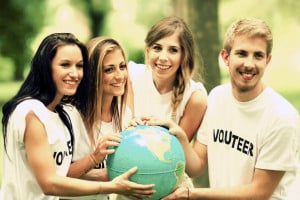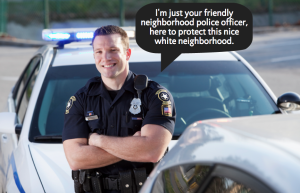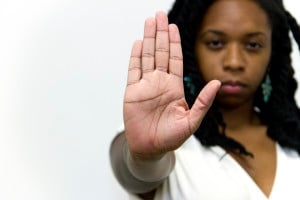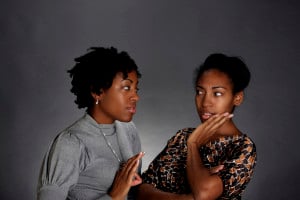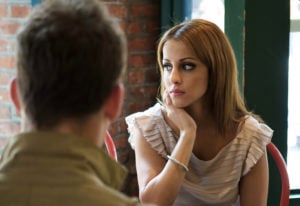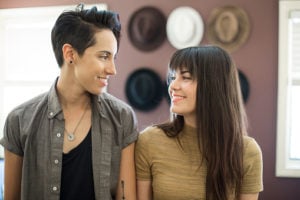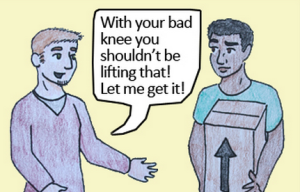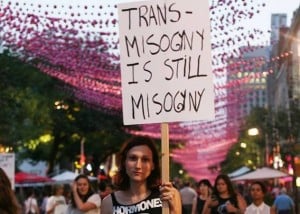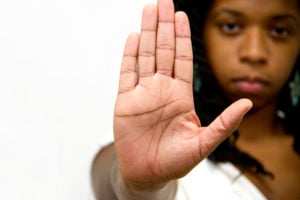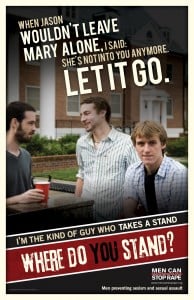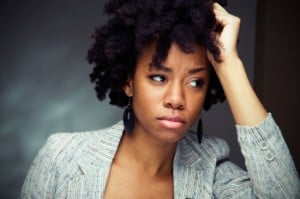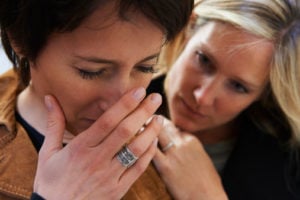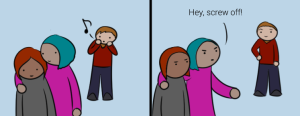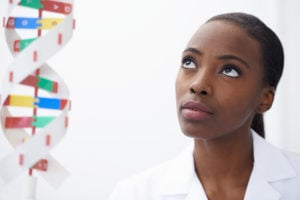
A person looks contemplative as they gaze at a model of DNA.
Two years ago, I finally decided to take a DNA analysis for ancestry.
From my teen years on, I lamented how little information I knew about my ancestors, both recent and distant, and that led to feelings of uncertainness. I’m not quite sure what I was uncertain about, but I always felt like I couldn’t prove my claim to any homeland.
Born in the Dominican Republic and raised in New York City led to even more hesitation when it came to choosing what to call myself.
My mother and her entire family are light-skinned Dominicans from el Cibao region, in the Dominican Republic, a region historically known for Taíno settlements, and later Spanish and French settlements, and which still has a large population of white Dominicans. On the other hand, my father and his family are Black from the coastal city of Santo Domingo.
I always considered myself Dominican, but that’s not a race – and it wasn’t clear cut enough for a brown girl with straight hair living in a predominantly Black neighborhood in New York City. So then I started calling myself Latina in high school.
It’s still not a race, but it served a purpose in a society that really wanted me to pick a side.
When asked if I was white by schoolmates, I would answer with a resounding “NO!” But then would say that I did have Dominican relatives that were light-skinned, but I never considered them white Americans due to the immense cultural differences between groups.
When asked if I considered myself Black, the answer was never “no.” It felt more complicated due to my connection with the Black community in the United States and in the Dominican Republic. I would say my father is Black, and so is his family, so I could be called mixed, like most Dominicans are.
I definitely felt a closer connection to Blackness growing up in the United States, but I still felt uncomfortable calling myself Black. I may come from an island of people who are predominantly Black and with whom I share a heritage, culture, and ancestry with, but my straight hair and light skin afford me privileges in the Latinx community that I cannot discount.
Calling myself indigenous was out of the question. I was always taught that all indigenous Dominicans died at the hands of early colonizers, and that although I had “indian” skin tone, I had no indigenous ancestry.
Regardless of what racial and ethnic makeup my ancestors were, the one constant was a lack of information.
I never had a family tree, and I barely knew the real names of my own grandparents due to a penchant for nicknames that people forgot long ago how they came about.
Birth and death records are non-existent. Finding a picture of a great grandparent is a miracle. Remembering where people were born, in what year, and who their parents were is still a constant struggle in my family.
It was confusing to me as a teenager. And as much as I’d like to believe I’m more informed now, the older I get, the more the confusion compounds.
People of color, particularly in the US and Latin America, have been stripped of their cultural identity through oppression, colonization, slavery, and genocide.
The feeling of “not knowing” is a pressing issue for many of us, and it creates an identity that is ever shifting and shoddy.
While some people can trace their lineage through documentation to find their ancestral origins, many people of color can’t always do that – and are therefore made to assume a racial identity that may or may not align with their experiences or assuage our need to find a place where we belong.
The commercialization of DNA analysis has placated the universal yearning to know where we came from.
DNA analysis gives us a glimpse into a past that many of us only read about in history books, and while scientific answers feel like the arbiter of the correct response, only we can decide what the results mean for us.
For descendants of colonization, genocide, and slavery, finding our origins, and in turn our identity, can be especially validating.
I consider myself a somewhat cynical person. I’m often the person in my circle of friends who responds with “well, that makes sense considering…” after hearing almost any type of news.
Maybe it’s because I’m an oldest child and always felt responsible for co-parenting my younger sisters, or maybe I’m just skeptical by nature. I needed to have answers, for me, for them, for anyone who asked.
It was only natural that I would one day spend more money than I care to admit to have scientific answers to the questions I could not answer, even as I knew that the science was every shifting and at times problematic.
I also knew that regardless of what the results showed, I couldn’t trace that lineage. Everyone in my family has called themselves “Dominican” for far too long, and figuring out specific locations of origin for European, African, and Native American ancestors still seems improbable, at least for me.
But upon learning my own DNA results, I was nonetheless emotional.
It didn’t really matter that I couldn’t interpret the results with accuracy, because I was looking for a place to start my journey, not necessarily for a bridge to the past.
The following weeks were spent relearning all that I knew about DNA and what story it told.
I realized that there was so much I didn’t know, and I made it my mission to understand it and pass the information on to anyone seeking for the same answers.
Researching, interviewing, and analyzing makes me feel that I am not alone in the confusion.
1. What Is DNA and How Do We Inherit It?
Most of us are familiar with websites that sell DNA kits for ancestry. But more often than not, it’s unclear how the information gathered from your cheek swab or saliva sample can actually tell your ancestry.
Many books have been written on the topic, and this is a topic that could take years to learn in an academic and professional environment, but for the sake of clarity and brevity, this will be a very broad explanation.
Our DNA contains our hereditary information and is contained within every single one of our cells. The information is stored in chemical bases that pair up to create strings of information called genes, which bundle together to create our 23 chromosome pairs, one half from each parent. This is our genome.
Of the 23 pairs of chromosomes, 22 of them are autosomal DNA, which holds a mix of genetic information inherited from our parents.
Autosomal DNA is an admixture containing half the DNA from each of your parents. And this is the information gathered in popular kits that give us our ancestral mixture. Scientists extract information from our autosomal DNA via a sample of saliva or skin cells to determine where our recent ancestors came from.
Other, more precise tests, look at the DNA that is passed as an unchanged block of information through paternal and maternal lines. Our maternal heritage is located in the mitochondria of the cell, and traceable by all of us. Paternal lineage is found in the sex chromosome “y” and is passed on from fathers to sons. If traced it can take us back the person who started your maternal and paternal lineage.
Scientists match sections of ones DNA to reference databases for living populations.
Human’s first ancestors originated in Africa, but as groups migrated throughout the world and settled in new places, their genes adapted to the environment and living conditions. Genes controlling things like skin pigmentation, hair type, and immunity mutated to adapt. By looking at the frequency for which specific mutations or polymorphisms show up in ones genome, scientists can match them to populations around the world.
For example, people who settled in Europe where the weather is cold and sunlight is limited experienced mutations, or polymorphisms, in their genes to develop fair skin that made them better suited for the environment.
Likewise, people in cold and mountainous regions in Asia developed a deep eye fold, which is largely believed to be an adaptation to windy environments. This same fold is common in Native American people, which is evidence of people in Asian and Northern Russia crossing over a landmass that once connected Canada to Asia, settling a new geographical region.
As Dr. Rick Kittles is quoted as saying in The Social Life of DNA, “We inherit [mutations] from our parents, our parents from their parents. And we can then trace these genetic variants within a family but also within a community. And those communities within continents.”
2. Is Our Identity Given to Us or Created by Us?
While gathering information for this article, I spoke with a Latinx friend who had taken a test to confirm her ancestry. Discovering that she had more than 50% Native American ancestry, she opted to call herself Indigenous-Latinx. It’s a controversial claim, and one that not everyone agrees is proper.
For her, it was a move to recapture her ancestry and disassociate herself with European ancestry.
Deemphasizing European ancestry for descendants of European colonization and slavery is a common theme among activists and social justice warriors, and one that I personally support with a little caution.
I certainly feel no ethnic pride for Europe, and regardless of how I look, I feel like a fish out of water among white people and especially in Europe.
But my features have a distinct European flair – and if ancestral DNA is to be trusted, about 60% of my heritage is of European descent.
Unlike another friend who talked to me about her ancestry DNA results, I was not prepared for my results. She’s half white, and identifies as Black, and when her ancestry results only showed 45% African ancestry, she felt that it was painfully predictable.
Her deep knowledge of African ancestry in the United States, and the likelihood that her slave ancestors were raped by white slave owners, made her acutely aware of how that was going to reflect on her DNA.
I was not quite as nonchalant, which has a lot to do with my Latinx heritage and the fact that Blackness is so heavily based on skin color and features in the Dominican Republic.
The one-drop rule that governs Blackness in the United States is not accepted in Latin America, where colonization was about intermarrying and creating new generations that were to be loyal to Europe and as close to white as possible.
On the one hand, I want to uplift my African and Indigenous ancestors – not for the sake of diminishing my whiteness, but because they truly built the culture that I was born into: my culture. The music, the food, the customs, even our distinct form of Christian-like religions is based on major influences by the most subjugated people in Latin America.
On the other hand, I firmly believe that acknowledging the features that privilege me in my community is pivotal to dismantling anti-Blackness and racism within it.
Pretending like we’re really a happy melting pot is disingenuous. And whether or not I lay claim to whiteness or Europe, the only factor that matters is that I recognize that how I identify may not match what others see, but is entirely based on my lived experiences.
While discussing the topic with yet another friend, I understood just how difficult it is to reconcile how we identify when we’re presented with scientific answers that don’t match how we feel.
While I focused on moving away from my ancestral DNA results and mapping my genealogy based on oral history (a tradition lovingly passed on by my Dominican family), my friend was deeply disappointed to find out that although she calls herself Afro-Latina, her results said otherwise.
Suddenly, I became an instructor and not a silent observer.
As I grappled with an analogy that might help her better understand the situation, I recalled a passage from Alondra Nelson’s book The Social Life of DNA. In her book, she compares the information gathered through DNA to an upside down triangle. The lines that make up the sides are the genes you inherited from your parents, which carries information they inherited from their own parents and so on.
Then there’s the large area in the center of the triangle, representing all the heritage in your ancestry that you did not inherit, but is crucial to your identity.
Although my friend may have inherited genes for curly hair, a wide nose, and light skin, it meant very little in comparison to the culture and traditions she learned from her family, which makes up a large portion of her essential being.
It’s a feeling I’ve sat with for years – and I’m not convinced it will ever leave me.
Wanting to do right by your ancestors, refusing to accept a whitewashed identity, realizing that you can’t change the past, choosing an identity that feels comfortable today, and restarting in the morning.
The only thing constant is the absolute knowledge that we can only move forward.
3. What Can’t DNA Tell Us?
It’s difficult to discuss science and heritage, because it all feels abstract – particularly for those of us who don’t know much about our heritage.
Yet precisely because communities with a legacy of colonization and slavery have been uprooted and disenfranchised, claiming a physical motherland, or a link to your paternal and maternal ancestors, serves as an anchor for communities that are in flux.
Results of DNA analysis may not be helpful in any concrete way. It’s unlikely you can use it to get citizenship of another country, and you won’t feel a kinship to the people whose DNA markers you share. But it serves the purpose of helping us understand and start the healing process.
What ancestral DNA kits tells us is accurate, to the extent that the science allows, but it really isn’t the entire picture.
Ancestral DNA companies look at markers on your genes and compares it to their database of collected genetic information from around the world, with the assumption that there are four biologically distinct populations: Africans, Asians, Europeans, and Native Americans.
Ethnic groups for which data has not been collected are not present in databases. So if you were to have markers that connect you to that group, the information won’t be reflected in your results. Furthermore, databases are proprietary to each company, so that if one company has more data, you may get better results.
However, you only inherit half of your parents’ genes – so a lot of ancestral genetic information is lost from generation to generation. In fact, because humanity has so many generations of ancestors, we can only trace our recent ancestry back ten generations, or roughly 300 years.
What you do inherit makes you unique, and it’s very likely that a sibling will have a completely different distribution of the same ancestral DNA.
That’s why it’s important to choose how we identify on more than just science.
***
I recently learned that my maternal lineage traces to the Americas.
Tracing this lineage (called haplogroup) backwards takes me back through a litany of maternal ancestors that left Africa some 60,000 years ago, settled in the Middle East for several thousand years more, then migrated through Asia into what we now call the Americas – and there, the woman whose genes I still carry today was born.
It’s unlikely I will ever call myself an indigenous woman. I haven’t lived through the experiences of indigenous people in the Caribbean, Latin America, or the Americas at large, which to me shapes identify far more than microscopic strings of information.
But I would be lying if I said that it didn’t mean something profound to me.
Growing up, I often compared my features to those of my parents and grandparents, trying to determine who I got my features from and then tying those features to a race or ethnicity.
I have my father’s African nose, my mother’s European hair, my grandmother’s skin tone: trigueña. It means “the color of wheat” and is the skin tone that Dominicans attribute to Taino ancestry.
European colonization eradicated entire cultures, including their languages, traditions, religions, and overall way of life to create a population that was Christian, identified as white, and was loyal to Europe.
A study about the Dominican Republic maternal heritage shows that 86% of the people have African ancestry, 9.4% have indigenous heritage, and only 0.08% have European maternal lineage.
It paints a picture of generations of indigenous and African woman giving birth to children fathered by European men. And if we know anything about colonization and slavery, it’s that nothing is ever consensual.
Our colonizers attempted to homogenize us by force.
Yet here I am, 500 years later, restoring knowledge, reclaiming my land, my people, and myself, and not for Europe.
[do_widget id=’text-101′]
Patricia Valoy is a Civil Engineer, feminist blogger, and STEM activist living in New York City. She writes about feminist and STEM issues from the perspective of a Latina and a woman in engineering. You can read more of her writings on her blog Womanisms, or follow her on Twitter @besito86. Read her articles here and book her for speaking engagements here.
Search our 3000+ articles!
Read our articles about:
Our online racial justice training
Used by hundreds of universities, non-profits, and businesses.
Click to learn more





